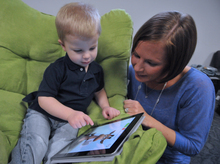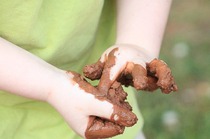We know mindfulness is good for us. Mindfulness allows us to be present in our parenting, choosing a skillful response, instead of succumbing to our visceral reactions.
Mindfulness is also good for our kids. There is an emerging body of research that indicates mindfulness can help children improve their abilities to pay attention, to calm down when they are upset and to make better decisions. In short, it helps with emotional regulation and cognitive focus. Do I even need to ask if you want that for your kids?
So where do we start? How can we teach these important skills to our children?
First things first...
Establish your own practice. You would have trouble teaching your children ballet if you had never danced. To authentically teach mindfulness to your children, you need to practice it yourself. You can start slowly with a meditation practice of just five to 10 minutes a day. Find ways to incorporate mindfulness into your daily activities. Don't let this step intimidate you -- you're probably practicing a lot of mindful habits already!
Keep it simple. Mindfulness is a big word for young kids to understand. Put simply, mindfulness is awareness. It is noticing our thoughts, feelings, bodily sensations, and anything that is around us and happening right now.
Check your expectations. Are you expecting mindfulness to eliminate tantrums? to make your active child calm? to make your house quiet? If so, you are likely to be disappointed. While feeling calm or being quiet are nice side-effects of mindfulness, they are not the ultimate purpose.
The purpose of teaching mindfulness to our children is to give them skills to develop their awareness of their inner and outer experiences, to recognize their thoughts as "just thoughts," to understand how emotions manifest in their bodies, to recognize when their attention has wandered, and to provide tools for impulse control. It is not a panacea, and it will not completely get rid of what is, frankly, normal kid behavior, like tantrums and loudness and whining and exuberance and arguing...
Don't force it. If your kids aren't interested in your lesson or activity, drop it. This is a good time for you to practice non-attachment to outcomes!
Now that we've got the preliminaries out of the way, here are some suggestions for how you can begin to introduce mindfulness to your children:
1. Listen to the bell. An easy way for children to practice mindfulness is to focus on paying attention to what they can hear. You can use a singing bowl, a bell, a set of chimes or a phone app that has sounds on it. Tell your children that you will make the sound, and they should listen carefully until they can no longer hear the sound (which is usually 30 seconds to a minute).
2. Practice with a breathing buddy. For young children, an instruction to simply "pay attention to the breath" can be hard to follow. In this Edutopia video, Daniel Goleman describes a 2nd-grade classroom that does a "breathing buddy" exercise: Each student grabs a stuffed animal, and then lies down on their back with their buddy on their belly. They focus their attention on the rise and fall of the stuffed animal as they breathe in and out.
3. Make your walks mindful. One of my children's favorite things to do in the summer is a "noticing walk." We stroll through our neighborhood and notice things we haven't seen before. We'll designate one minute of the walk where we are completely silent and simply pay attention to all the sounds we can hear -- frogs, woodpeckers, a lawnmower. We don't even call it "mindfulness," but that's what it is.
4. Establish a gratitude practice. I believe gratitude is a fundamental component of mindfulness, teaching our children to appreciate the abundance in their lives, as opposed to focusing on all the toys and goodies that they crave. My family does this at dinner when we each share one thing we are thankful for. It is one of my favorite parts of the day.
5. Try the SpiderMan meditation! My 5-year-old son is in to all things superheroes, and this SpiderMan meditation is right up his alley. This meditation teaches children to activate their "spidey-senses" and their ability to focus on all they can smell, taste, and hear in the present moment. Such a clever idea!
6. Check your personal weather report. In Sitting Still Like a Frog, Eline Snel encourages children to "summon the weather report that best describes [their] feelings at the moment." Sunny, rainy, stormy, calm, windy, tsunami? This activity allows children to observe their present state without overly identifying with their emotions. They can't change the weather outside, and we can't change our emotions or feelings either. All we can change is how we relate to them. As Snel describes it, children can recognize, "I am not the downpour, but I notice that it is raining; I am not a scaredy-cat, but I realize that sometimes I have this big scared feeling somewhere near my throat."
7. Make a Mind Jar. A mind jar is a bit like a snow globe - shake it up and watch the storm! But soon, if we sit and breathe and simply watch the disturbance, it settles. As do our minds.
8. Practice mindful eating. The exercise of mindfully eating a raisin or a piece of chocolate is a staple of mindfulness education, and is a great activity for kids. You can find a script for a seven-minute mindful eating exercise for children here.
Above all, remember to have fun and keep it simple. You can provide your children with many opportunities to add helpful practices to their toolkit -- some of them will work for them and some won't. But it's fun to experiment!
http://www.huffingtonpost.com/sarah-rudell-beach-/8-ways-to-teach-mindfulness-to-kids_b_5611721.html?utm_hp_ref=tw







